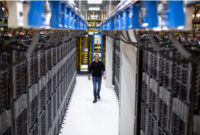Cloud computing is a broad term that refers to the delivery of hosted computing and IT services via the internet on an on-demand basis, with a pay-as-you-go pricing model. Users can access technology services like processing power, storage, and databases from a cloud provider, which negates the necessity to buy, operate, and maintain physical data centers and servers on-site. cloud server
A cloud can be classified as private, public, or hybrid. A public cloud offers services to any user on the internet. In contrast, a private cloud is a proprietary network or data center that provides hosted services to a select group of users, with specific access and permission settings. A hybrid cloud combines elements from both public and private clouds, enabling the sharing of data and resources in a mixed environment. Regardless of its type, cloud computing aims to ensure simple and scalable access to IT services and computing resources.
Cloud infrastructure consists of the hardware and software components essential for effectively deploying a cloud computing model. Cloud computing is sometimes referred to as utility computing or on-demand computing.
The term cloud computing was derived from the cloud symbol commonly used to depict the internet in cloud server diagrams and flowcharts.
How does cloud computing/cloud server operate?
Cloud computing allows client devices to access leased computing resources such as data, analytics, and cloud applications over the internet. It depends on a network of remote data centers, servers, and storage systems that are owned and managed by cloud service providers (CSPs). These providers are accountable for the storage capacity, security, and computing power necessary to handle the data sent by users to the cloud.
An internet network connection serves as a link between the front end—comprising the accessing client device, browser, network, and cloud software applications—and the back end, which includes databases, servers, operating systems, and computers. The back end operates as a repository, storing the data accessed by the front end.
A central server regulates communication between the front and back ends, utilizing protocols to facilitate data exchange. This central server employs both software and middleware to manage the connectivity between various client devices and cloud servers. Typically, a dedicated server is assigned for each application or workload.
The following steps are usually involved in cloud server.
- A customer starts a request for a cloud service, such as file storage, application execution, or data analysis. This request is transmitted to a cloud provider through the internet.
- The request arrives at a large data center operated by the cloud provider, which contains thousands of servers, storage systems, and networking equipment.
- The cloud provider’s software distributes the necessary resources, such as virtual servers, storage space, and network bandwidth, to satisfy the customer’s request. This allocation is dynamic, as resources are assigned and de-allocated as required.
- The assigned resources execute the request. For instance, if a file is being stored, it is uploaded to a specified storage location; if an application is being run, it is executed on a virtual server.
- Once the operation is finished, the outcome is sent back to the customer over the internet. This may include the stored file, the application’s output, or the results of the data analysis.
- The cloud provider typically bills the customer based on the resources utilized, such as the amount of storage consumed, compute time, or network bandwidth.
Cloud server significantly relies on automation and virtualization technologies. Virtualization enables IT organizations to create virtual instances of servers, storage, and other resources, allowing multiple virtual machines (VMs) or cloud environments to operate on a single physical server through a software known as a hypervisor. This simplifies the abstraction and allocation of cloud resources into logical entities, making it easier for users to request and utilize these resources. Additionally, automation and orchestration capabilities offer users a high degree of self-service, enabling them to provision resources, connect services, and deploy workloads without direct involvement from the cloud provider’s IT personnel.
What advantages does cloud computing offer?
Cloud computing delivers numerous advantages for contemporary businesses, such as the following:
Cost management.
Utilizing cloud infrastructure can lower capital expenses, as organizations are not required to invest substantial amounts in purchasing and maintaining equipment; investing in hardware, facilities or utilities; or constructing large data centers to support their expanding enterprises. Moreover, companies do not require large IT teams to manage cloud data center operations since they can depend on the expertise provided by their cloud service providers. Additionally, cloud computing reduces costs associated with downtime. As downtime is infrequent in cloud computing, businesses do not have to spend resources and time addressing issues that could relate to outages.
Data and workload mobility.
Keeping data in the cloud allows users to access it from anywhere using any device with an internet connection. This means users do not need to carry USB drives, external hard drives, or multiple CDs for data access. They can reach corporate data via smartphones and other mobile devices, enabling remote employees to stay connected with colleagues and clients. End users can effectively process, store, retrieve, and back up resources in the cloud. Additionally, cloud providers take care of all updates and upgrades automatically, saving both time and effort.
Business continuity and disaster recovery.
All organizations are concerned about potential data loss. Storing information in the cloud ensures that users can always retrieve their data, even if their devices, like laptops or smartphones, become unusable. With cloud-based solutions, businesses can promptly recover their data following natural disasters or power outages. This supports business continuity and disaster recovery (BCDR) efforts and helps guarantee that workloads and data remain accessible, even in the face of damage or disruption to the business.
Speed and agility.
Cloud computing enables the quick deployment of applications and services, allowing developers to rapidly provision resources and test new concepts. This removes the necessity for lengthy hardware procurement processes, thereby speeding up time to market.
Environmental sustainability.
By optimizing resource utilization, cloud computing contributes to environmental sustainability. Cloud service providers can reduce energy expenses and lower their carbon footprint by consolidating workloads onto shared infrastructure. These providers frequently run large-scale data centers designed for energy efficiency.
Automatic updates.
Cloud services typically come with automatic updates, ensuring that users always have access to the latest features and security fixes without needing manual intervention.
What are the various types of cloud computing services?
Cloud services can be categorized into several key delivery models:
Infrastructure as a Service (IaaS).
IaaS providers, including Amazon Web Services (AWS), offer a virtual server instance along with storage and application programming interfaces (APIs) that enable users to migrate workloads to a virtual machine (VM). Users are allocated a specific storage capacity and have the flexibility to start, stop, access, and configure the VM and storage as needed. IaaS providers supply small, medium, large, extra-large, and memory- or compute-optimized instances, alongside the option to customize instances based on various workload requirements. The IaaS model is the closest equivalent to a remote data center for business users.
Platform as a Service (PaaS).
In the PaaS model, cloud service providers host development tools on their systems. Users access these tools via the internet utilizing APIs, web portals, or gateway software. PaaS is primarily utilized for general software development, with many PaaS providers hosting the developed software afterward. Examples of PaaS offerings include Salesforce Lightning, AWS Elastic Beanstalk, and Google App Engine.
Software as a Service (SaaS).
The SaaS delivery model provides software applications over the internet, often referred to as web services. Users can reach SaaS applications and services from any place using a computer or mobile device with internet connectivity. In this model, users gain access to application software and databases. An example of a SaaS solution is Microsoft 365 for productivity and email services.
Function as a Service (FaaS).
FaaS, commonly known as serverless computing, allows users to run code in the cloud without concerning themselves with the underlying infrastructure. Users can develop and deploy functions that respond to events or triggers. FaaS abstracts server and infrastructure management, enabling developers to focus solely on writing code.
Cloud computing offers various deployment models, which include the following options:
Private cloud
In a private cloud, the data center of an organization provides cloud services exclusively to its internal users. This model requires the organization to develop and manage its own cloud infrastructure, combining the benefits of cloud technology with the control, management, and security typical of in-house data centers. Internal users may incur costs for services through an IT chargeback system.
Notable technologies and vendors for private cloud solutions include AWS, Citrix Cloud, IBM Cloud, OpenStack, and VMware.
Public cloud
The public cloud model involves a third-party cloud service provider (CSP) delivering services via the internet. Resources here are shared among multiple organizations, promoting efficiency and scalability.
Services in the public cloud are typically charged on an on-demand basis, often by the hour or minute; however, many services also offer long-term commitments. Customers pay solely for the computing cycles, storage, or bandwidth they utilize. Well-known public CSPs include AWS, Google Cloud Platform (GCP), IBM, Microsoft Azure, Oracle, and Tencent Cloud.
Hybrid cloud
A hybrid cloud integrates public cloud services with a private cloud hosted on-premises, featuring automation and orchestration between the two. This allows businesses to run sensitive applications or critical workloads in the private cloud while using the public cloud for handling demand spikes.
The aim of a hybrid cloud is to establish a cohesive, automated, and scalable environment that leverages the advantages of public cloud infrastructure while maintaining control over essential data.
Multi-cloud
More organizations are adopting a multi-cloud strategy, which involves utilizing multiple Infrastructure as a Service (IaaS) providers. This approach allows applications to migrate between different providers or run simultaneously on two or more platforms.
The reasons organizations choose multi-cloud include reducing the risk of downtime from a service outage and benefiting from competitive pricing from specific providers. It also helps companies avoid vendor lock-in, enabling them to switch providers when necessary.
Nevertheless, developing applications and deploying them across multiple clouds can be challenging due to the variations in the services and APIs of different cloud providers.
As cloud providers strive for standardization and convergence of services and APIs, multi-cloud deployments are expected to become less complex. Initiatives like the Open Cloud Computing Interface seek to enhance interoperability and ease multi-cloud deployments.
Community cloud
A community cloud serves a specific group with shared concerns, missions, policies, security needs, and compliance requirements. Such a cloud can be operated by the member organizations or managed by a third-party vendor and may be located on-premises or off-premises.
Characteristics of cloud computing
Cloud computing has existed for several decades, and contemporary cloud infrastructure exhibits a range of characteristics that provide significant advantages to businesses of various sizes.
Key traits of cloud computing include the following:
- Self-service provisioning. Users can initiate computing resources for nearly any workload as needed. This empowers end-users to provision capabilities, such as server time and network storage, without relying on IT personnel to manage these resources.
- Elasticity. Organizations can easily increase or decrease their computing capacity based on demand, eliminating the necessity for large investments in infrastructure that may not always be utilized.
- Pay per use. Cloud resources are tracked at a granular level, allowing users to only pay for what they actually utilize in terms of resources and workloads.
- Workload resilience. Cloud service providers often implement redundant resources to guarantee robust storage and ensure that critical workloads remain operational, frequently across several global locations. cloud server
- Migration flexibility. Organizations have the ability to automatically relocate specific workloads to or from the cloud or between different cloud platforms.
- Broad network access. Users can access cloud data or upload information to the cloud from any location with internet connectivity, using a variety of devices.
- Multi-tenancy and resource pooling. Multi-tenancy permits various customers to share the same physical infrastructure or applications while maintaining individual privacy and security over their data. Resource pooling allows cloud providers to serve numerous clients from shared physical resources. These resource pools should be sufficiently large and adaptable to meet the diverse needs of multiple customers.
- Security. Security is a fundamental aspect of cloud computing, and the majority of providers prioritize the implementation and upkeep of security measures to safeguard the confidentiality, integrity, and availability of the data hosted on their platforms. Alongside robust security features, providers often offer various compliance certifications to ensure their services meet established standards.
Cloud computing has progressed and expanded into a vast range of services and functionalities aimed at meeting various business requirements. Some instances of cloud computing cloud server capabilities and variety include the following:
- Users can access Google Docs and Microsoft 365 online, enabling them to be more productive by reaching their work presentations and spreadsheets stored in the cloud at any time, from any location, and on any device.
- Services like email, calendars, Skype, and WhatsApp leverage the cloud’s ability to allow remote data access, enabling users to review their data on any device, whenever and wherever they choose.
- Zoom serves as a cloud-based platform for conducting video and audio conferences, allowing meetings to be recorded and stored in the cloud for users to access anytime and anywhere. Microsoft Teams is another prevalent tool for communication and collaboration.
- AWS Lambda enables developers to execute code for applications or back-end services without the need to provision or manage servers. Its pay-as-you-go structure supports real-time fluctuations in data storage and usage. Other notable cloud providers with serverless computing options include Google Cloud Run Functions and Microsoft Azure Functions.
- Salesforce functions as a cloud-based platform for customer relationship management that assists businesses in managing their sales, marketing, and customer service functions.
- Dropbox is a cloud storage platform that allows users to save files online and retrieve them from any device. It also facilitates file sharing and collaboration.
How is cloud server actually utilized?
The extensive range of services and functionalities provided by modern public clouds has been applied to numerous use cases, including the following:
- Tailored environments for testing and development can accelerate timelines and help meet milestones.
- Organizations utilize the public cloud to host live production workloads, which requires careful planning and architecture of the necessary cloud resources and services to establish an operational environment for the workload and ensure its required resilience.
- Cloud storage enables flexible, scalable remote data centers that provide valuable insights through big data analytics. Leading cloud service providers offer specialized services for big data analytics projects, such as Amazon EMR and Google Cloud Dataproc.
- IaaS allows businesses to host IT infrastructures and access scalable computing, storage, and networking capabilities. Pay-per-use subscription models are economically beneficial, helping organizations reduce initial IT expenses.
- PaaS facilitates companies in developing, running, and managing applications with greater ease, flexibility, and at lower costs than maintaining an on-premises platform. PaaS can also enhance application development speed and enable higher-level programming.
- Organizations have the flexibility to utilize either public or private clouds for different workloads and applications to optimize costs and efficiency through a hybrid cloud approach.
- Employing services from multiple distinct cloud providers can help users find the most suitable cloud service for diverse workloads with specific needs.
- Organizations can store extensive amounts of data remotely, allowing for easy access. Clients only pay for the storage they utilize.
- The cloud generally offers quicker recovery solutions than traditional on-site disaster recovery methods, usually at a lower cost.
- Cloud backup solutions tend to be more user-friendly, alleviating concerns about availability and computing capacity, as the cloud provider takes care of data security.
- Cloud computing provides access to artificial intelligence as a service, allowing individuals without formal data science training to benefit from AIaaS. For instance, a web developer might create a facial recognition application still leveraging their web development knowledge. AI as a service is integrated into the cloud and obtainable via APIs, enabling users to automate routine tasks, saving both time and labor costs. Businesses can enhance decision-making processes by utilizing AI to project outcomes based on historical data patterns.
- Cloud computing makes it easier to manage and process data from Internet of Things devices. Cloud platforms provide the necessary scalability and processing power to deal with the vast quantities of data generated by IoT devices, supporting real-time analytics and decision-making. For example, smart home systems like Google Nest or Amazon Alexa can gather data on energy consumption within the home and leverage cloud computing to analyze this data, offering the homeowner suggestions on reducing energy usage.
- Social networking. While cloud computing is primarily linked to business applications, it is also extensively utilized in social networking. For instance, platforms like Meta, X, and LinkedIn showcase the SaaS model of cloud computing, allowing users to connect and share through tweets, photos, messages, and social media updates.
Cloud computing vs. traditional web hosting
Due to the various services and features offered by the public cloud, there has been some misunderstanding about the distinction between cloud server and significant uses like web hosting. Although the public cloud is frequently employed for web hosting, the two concepts are quite different. Major advancements in virtualization and distributed computing, along with improved access to high-speed internet, have spurred interest in cloud computing.
The unique attributes of cloud computing that set it apart from traditional web hosting include the following:
- Cloud computing enables users to access substantial computing power on an as-needed basis—usually billed by the minute or hour. In traditional hosting, users generally pay for a predetermined quantity of storage and processing power. As their needs expand, businesses can consider virtual private servers or dedicated hosting.
- Cloud computing is elastic, allowing users to use as much or as little service as they require at any given moment. Traditional hosting often limits scalability, especially in shared hosting. Shared hosting entails multiple websites sharing the same server resources, which can potentially lead to performance issues and slower website speeds during traffic surges.
- Cloud computing services are fully managed by the provider; all the consumer needs is a PC and internet access. Although shared traditional hosting is also managed by the provider, users are typically required to manage their websites via a user-friendly interface, such as cPanel.
- Cloud hosting is generally more reliable than traditional hosting. Cloud service providers maintain redundant infrastructure and operate over numerous data centers, minimizing downtime and enhancing availability. Traditional hosting relies on a single server, making it more vulnerable to hardware failures and higher risks of downtime.
- Both cloud hosting and traditional hosting involve security concerns. Cloud hosting providers invest significantly in security measures to protect data and infrastructure. However, certain organizations may find traditional hosting preferable, as it offers greater control over security and can meet specific security needs.
- Cloud computing typically delivers superior performance compared to traditional web hosting by distributing workloads across various servers, resulting in faster load times and an improved user experience. The performance of traditional web hosting can be impacted by the number of users sharing server resources, which may cause slower load times during peak usage.
Future of Cloud Server and Emerging Technologies
Cloud computing is anticipated to experience significant advancements and the incorporation of innovative technologies. A report from Grand View Research predicts that the global public cloud services market will expand at a compound annual growth rate (CAGR) of 21.2% from 2024 to 2030.
Several major trends and important factors influencing the future of cloud computing are outlined below:
Digital Transformation.
Organizations are increasingly shifting their essential workloads to public cloud platforms. This transition is largely driven by business executives who wish for their companies to remain competitive in the evolving landscape of digital transformation, which is prompting the demand for the public cloud.
Fewer Barriers to Adoption.
Business leaders are also turning to the public cloud to leverage its flexibility, modernize internal computing infrastructure, and empower critical business units along with their DevOps teams. Cloud service providers, including IBM and VMware, are focusing on fulfilling the requirements of enterprise IT by reducing the barriers to public cloud adoption that previously deterred IT decision-makers from fully embracing the public cloud.
Public Cloud is Ready for Mission-Critical Apps.
Traditionally, enterprises considering cloud adoption primarily concentrated on new cloud-native applications—those designed and built with cloud services in mind—since they were hesitant to transition their most mission-critical applications to the public cloud. However, organizations are beginning to recognize that the cloud is suitable for enterprise needs, provided they choose the appropriate cloud platforms.
Advanced FinOps Cost Controls.
The emergence of advanced FinOps practices for overseeing cloud computing expenditures represents a significant trend in cloud computing. As cloud environments grow more intricate and costs increase, organizations are implementing AI-driven tools and strategies to optimize their spending. By utilizing analytics, automation, and machine learning, advanced FinOps helps pinpoint inefficiencies, anticipate future costs, and offer proactive approaches to enhance the value of cloud investments.
Expansion of Serverless Offerings.
As cloud providers compete vigorously for market share, the public cloud is continually evolving, expanding, and diversifying its service offerings. This competition has led public IaaS providers to deliver a wider range of services beyond standard compute and storage instances. For instance, serverless or event-driven computing is a cloud service that performs specific tasks like image processing and database updates. In traditional cloud deployments, users must set up a compute instance and load their code into it, then determine how long to operate and pay for that instance. In contrast, with serverless computing, developers write code, and the cloud provider executes it in response to actual events, eliminating the need for users to manage the server or instance. Users are only charged for the transactions that the function carries out. Examples of serverless computing services include AWS Lambda, Google Cloud Run Functions, and Azure Functions.
Big Data Services.
Public cloud computing is also well-suited for processing big data, which typically requires significant compute resources over short periods. Cloud providers have addressed this need by offering big data services like Google BigQuery for extensive data warehousing and Microsoft Azure Data Lake Analytics for the processing of large data sets.
Growth of Edge Computing.
The demand for quicker data processing and real-time analytics is propelling the growth of edge computing. By processing data near its origin, edge computing minimizes latency and improves response times. This is particularly advantageous for applications that necessitate immediate data processing, such as IoT devices, autonomous vehicles, and real-time analytics. Integrating edge computing with AI facilitates real-time decision-making and advanced analytics at the edge without depending on continuous cloud connectivity.
Ready-to-Use Machine Learning and Large Language Model Offerings.
Another wave of upcoming cloud technologies and services relates to AI, machine learning, and large language models. These technologies offer a range of cloud-based, ready-to-use AI and machine learning services tailored to client requirements. Examples of these services include Amazon Machine Learning, Amazon Lex, Amazon Polly, Google Cloud Machine Learning Engine, and Google Cloud Speech API.
Blockchain.
The relationship between blockchain and cloud computing is expected to strengthen, as businesses acknowledge blockchain’s potential to enhance operational efficiency, security, and transparency. This trend is further supported by increased investments and the growth of blockchain-as-a-service platforms.



